A Time of Change
1913.
A year of great change in the United States. Woodrow Wilson just took office as our 28th President. The 16th and 17th Amendments to the Constitution were passed, leading to the direct election of senators and the income tax.
The Woolworth Building – then the tallest building in the world, is completed in New York City. The first packaged cigarettes were marketed, and Ford Motor Company created the most efficient assembly line seen to date. American railroad traffic was reaching its zenith.
52 African-Americans were lynched by domestic terrorists. The Eugenics Record Office, which would go on to advocate for the forced sterilization of the “socially undesirable,” was in operation on Long Island. Not all events and changes are good.
However, at this moment in time occurred one event which deserves particular focus, especially with our current political discourse and Thanksgiving being right around the corner.
1913 was at the zenith of Italian immigration.
Autrefois
During the first two decades of the 20th century, more than 3 million Italian immigrants came to America’s shores. Most of these newcomers were from the southern portion of the Italian peninsula, and about two-thirds possessed no skills outside of basic agriculture.
Interestingly, not all immigrants planned on staying in the United States. It was often the case that Italians did not learn English, and simply worked for a limited time in order to increase their savings and return home. Roughly half of the Italians who made the voyage repatriated.
Initially, many Italians lived in their own communities, often in tenements and slums which were rat-infested, had poor plumbing, and were dangerous to be in at night. In the workplace, these immigrants faced discrimination.
They were looked down upon, assigned to do the more dangerous jobs, and were often the only workers to work alongside African-Americans. For a time, they were considered “black” not just in American society, but in some cases, legally.
In the southern states at the time, Italians (particularly those from south Italy), were subjected to the racial segregation laws dominant in that region.
As time went on, those Italians who stayed in the United States became better integrated. Their communities mixed with those of other groups, and they were elected to various political offices.
Culturally, they were eventually considered “white people” – proof that racism is about more than just skin color, it is about class and power, and it is malleable.
In fact, many Irish-Americans at the time were angry that the “inferior” Italian immigrants would arrive and reduce their wages, despite the fact that the Irish were also considered “black” and that similar fears about them were raised in earlier decades.
Italian-Americans and their children founded many prominent companies we see today, including Planters Peanut Company, Home Depot, Ghirardelli Chocolate, Chef Boyardee, Bank of America, and many more.
Ultimately, Italian-Americans as a group overcame their initially low socioeconomic position, and by 1970, attained an average income equal to the national average.
Had the initial Italian immigrants at the turn of the century been turned back due to their meager economic circumstances and lack of skills, American cultural, economic, and political history would be far different.
The First Thanksgiving
1621.
Thanksgiving.
We all know the mythical story. The Pilgrims coming to the “New World,” and the native Wampanoag helping them. A grand feast in the autumn of 1621 between the Puritans and Wampanoag to celebrate the harvest. The First Thanksgiving.
That’s the story. Admittedly, there is actually very little we know of this event – and it was not even called “Thanksgiving” at the time.
In fact, it did not even become a holiday until the 19th century, when Abraham Lincoln declared it as such for the political purpose of boosting morale during the Civil War.
Furthermore, using Thanksgiving as a lens through which to view this historical period would produce a wildly inaccurate view of history. It would obscure the fact that colonization in this region proved to be horrible for the natives, and that the rosy picture painted of a peaceful feast was just a bright moment in an otherwise dark story.
That being said, I still like Thanksgiving. I like the romantic version of it – and the values it entails. Enjoying the fruits of hard work. Teaching others what you know. Helping people. Celebrating what you have in life. Being thankful.
Opening your communities to strangers.
Missing the Point
Five years ago, The Indianapolis Star came under fire for a political cartoon. The cartoon was crafted shortly after the executive order by then-President Obama which delayed the deportation of millions of undocumented immigrants.
The cartoon showed a stereotypical, white, American family sitting around the table for Thanksgiving Dinner. However, three people with darker skin and black  hair, including a man with a cap and mustache, are seen laughing and climbing through an open window.
hair, including a man with a cap and mustache, are seen laughing and climbing through an open window.
In the center of the cartoon is a man rolling his eyes, complaining that because of Barack Obama’s executive order, the family will “be having extra guests this Thanksgiving.”
It is with great irony that there are those who proclaim to love Thanksgiving, a holiday whose origins lay in a community sharing a meal with immigrants in hard times, yet sympathize with this cartoon family.
A Question of Legality?
2019.
Much has been made of how the U.S. government should handle today’s influx of migrants – particularly those from Latin America, particularly those who cross the southern border.
However, those who argue for harsh immigration policies aimed at such groups are starting at the wrong premise – that because said immigration is illegal, it must be prevented.
This assumption ignores several fundamental questions. The first of these is simply: why is such immigration illegal? Does keeping such immigration illegal make sense? Do all immigrants who cross the border stay? What makes them want to stay? What are the traits of these immigrants? Are those traits reflected in other groups which have come to America in the past? What are the economic implications of accepting such immigrants?
And most importantly, what immigration policy would be most in line with the values we claim to care about?
It is not my place to answer every question I just posed. However, it is imperative to show that the story of immigrants from Latin America greatly parallels that of Italians a century ago.
Many of these immigrants are unskilled, and are willing to perform many jobs which natives refuse to, particularly in agriculture and construction.
Just as Italian immigrants were heavily concentrated in the northeast, Latin American immigrants are heavily concentrated in the southwest.
It is often the case that these immigrants live in their own communities in American cities, and while their rate of English proficiency is actually fairly high by historical standards, it is still the case that many are not fluent.
Furthermore, a complaint made by many in regards to this group is about security. Namely, that because we don’t know the backstory of those who crossed the border, we should not allow any of them to stay, for security reasons.
But what about Italian immigrants in 1913? Did we “run background checks” on them? Furthermore, what information on migrants we did have during the early 20th century was far less than the amount which restriction advocates say we need today. Should they have all been kept out?
Italian immigrants arrived on cramped ships in droves to Ellis Island and other ports of entry, where government officials who knew little about them received them. They often had their names changed, and subsequently entered American society.
And did America fall apart? Did wages fall drastically and our economy collapse because of it? The record is clear, and overwhelming, that granting entry to largely uneducated, working-class immigrants from south Italy proved to be a remarkable success, despite what the shortsighted and often bigoted naysayers at the time proclaimed.
The Spirit of Thanksgiving
Be thankful this Thanksgiving, but recognize the fundamental values highlighted in the holiday’s origin.
Enjoy the time with your family and friends, but recognize that there are families in our history who endured great hardship to get here.
Enjoy the food, but recognize that were it not for hardworking immigrants, much of it would not even be grown.
Enjoy the freedoms that exist in this country, but recognize that there have been immigrants who fought in our military to defend them, and immigrants who were denied those same freedoms.
There is one freedom to be thankful for in particular: freedom of speech. The freedom to say how one feels, and even alienate others because of it. It is here where I wish to close.
You may disagree with my view of history, of the belief in immigration highlighted here.
That’s ok. What may not be ok is where that disagreement is derived from.
Is it over the substance, or is it from hate? From close-mindedness? From a lack of openness towards those who are different? From an ignorance of one’s own family history? From a shallow refusal to engage in complex issues?
Substantive disagreement is fine, and encouraged. But hostility due to the aforementioned reasons is not.
There are those who would say that the title of this piece alienates people.
But this shows that we need to discuss why, in 2019, on the day of Thanksgiving, some would feel alienated by the notion of thanking immigrants in the first place.
And to the idea that I am politicizing Thanksgiving, I have one simple answer:
I plead guilty.
